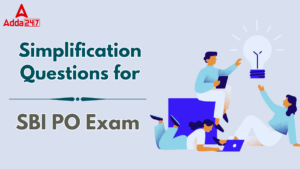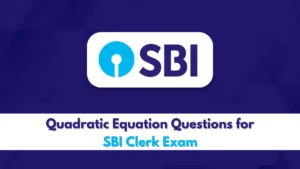Dear Students,
Quantitative Aptitude For SBI PO Exam 2018 (Week-02)
Quantitative Aptitude Section has given heebie-jeebies to the aspirants when they appear for a banking examination. As the level of every other section is only getting complex and convoluted, there is no doubt that this section, too, makes your blood run cold. The questions asked in this section are calculative and very time-consuming. But once dealt with proper strategy, speed, and accuracy, this section can get you the maximum marks in the examination. Following is the Quantitative Aptitude quiz to help you practice with the best of latest pattern questions.
Following the study plan for SBI PO Preliminary Examination 2018, the second week starts with practice questions on Number Series and Data Interpretation Questions Set. To ensure proper preparation of the section we advise you to go through all the questions sincerely and try to attempt each one of them. Afterward, match your solutions and the approach with the one that would be provided later. Practice more and more questions on the same section to enhance your grip over the topics. Following is the Quantitative Aptitude quiz to help you practice with the best of latest pattern questions.
Directions (1-5): Line-graph given below shows two types of vacancies i.e. CGL and CHSL notified by SSC in five different years. Study the data carefully and answer the following questions.
Q1. Total vacancies in year 2013 is what percent more than the total vacancies in 2012?
(a) 10%
(b) 12.5%
(c) 15%
(d) 17.5%
(e) 20%
Q2. In year 2014, 45% of CGL vacancies and 60% of CHSL vacancies remained vacant after the final selection. Find the total filled vacancies of CGL and vacancies of CHSL in year 2014.
(a) 928
(b) 948
(c) 978
(d) 920
(e) 960
Q3. CGL vacancies in 2012 is what percent of the CHSL vacancies in 2015?
(a) 38%
(b) 58%
(c) 52%
(d) 48%
(e) 42%
Q4. Total vacancies in year 2011 is filled by males and females. Number of females who are selected in SSC is 75% more than number of males who are selected in the same. Find the number of female who are selected in SSC in year 2011?
(a) 980
(b) 560
(c) 855
(d) 924
(e) 616
Q5. Find the total number of vacancies in year 2016, if total number of vacancies in 2016 is 40/3% more than total number of vacancies in 2015?
(a) 3098
(b) 3108
(c) 3118
(d) 3128
(e) 3138
Directions (Q6- 10): What will come in place of question mark (?) in the following number series.
Q6. 11, 6, 7, 12, 26, ?
(a) 65
(b) 66.5
(c) 67
(d) 67.5
(e) 68
Q7. 16, 24, 40, 72, ?, 264
(a) 136
(b) 138
(c) 140
(d) 144
(e) 146
Q8. 10, 10, 16, 40, 100, ?
(a) 200
(b) 205
(c) 210
(d) 215
(e) 220
Q9. ?, 3073, 2948, 2605, 1876, 545
(a) 3118
(b) 3109
(c) 3100
(d) 3091
(e) 3082
Q10. 20, 26, 36, 54, 84, ?
(a) 125
(b) 130
(c) 132
(d) 134
(e) 135
Directions (11-15): Bar graph given below shows income of Yogesh and Neeraj in five different months. Study the data carefully and answer the following questions:
Q11. If Yogesh and Neeraj spend 70% and 40% in March respectively, then find the total saving of Yogesh and Neeraj together in March?
(a) 45,000
(b) 55,000
(c) 50,000
(d) 70,000
(e) 60,000
Q12. Yogesh’s total salary in Feb, March and April together is what percent more or less than Neeraj’s salary in March April and May together?
(a) 25% less
(b) 25% more
(c) 75% less
(d) 75 % more
(e) 30 % less
Q13. Find the ratio between the average income of Yogesh to the average income of Neeraj throughout five years.
(a) 52 : 59
(b) 17 : 19
(c) 26 : 29
(d) 18 : 19
(e) 51 : 58
Q14. Yogesh spend his total salary of January, February and May together in two bonds that are DLF and Maurti. Amount spend by Yogesh on Maruti bonds is 25% more than amount spend by him on DLF bonds. Find the amount spend by Yogesh on Maruti bonds?
(a) 60,000
(b) 80,000
(c) 1,00,000
(d) 1,20,000
(e) 1,40,000
Q15. Neeraj saves 30% in February 40% in March, 45% in April and 50% in May. Find the total amount spent by Neeraj in Feb, March, April and May together?
(a) 95,000
(b) 1,35,000
(c) 1,25,000
(d) 1,15,000
(e) 1,00,000






 Simplification Questions for SBI PO Exam
Simplification Questions for SBI PO Exam
 SBI PO Quantitative Aptitude 2025, Impor...
SBI PO Quantitative Aptitude 2025, Impor...
 Quadratic Equation Questions for SBI Cle...
Quadratic Equation Questions for SBI Cle...





